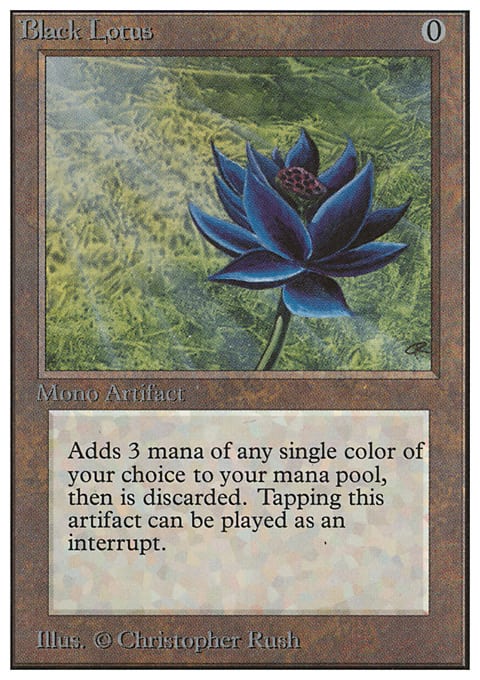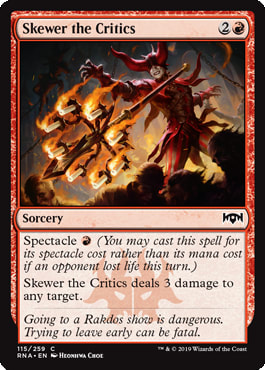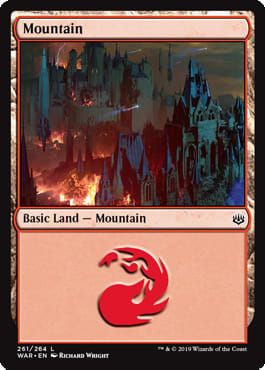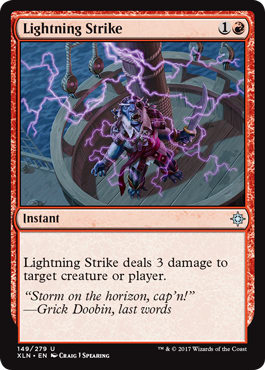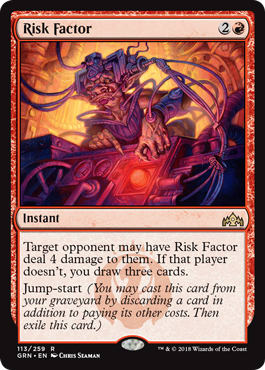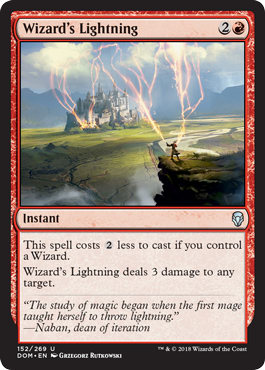From the first days of Magic: The Gathering, this artifact has been one of the most terrifying cards the opponent could possibly play. This is a card whose power has never found a real peer in the twenty-six years since those first Alpha packs were opened... Though there have certainly been some pretenders.
Dark Ritual - a Black Lotus for only one color that costs a color to start - has had its wings clipped in certain formats; as has Seething Song, a kind of Black Lotus with the upfront cost of a Black Lotus's desired effect.
You'd think that the ability to get a jump on mana might be one of the more exploitable angles for the aspiring Magic: The Gathering deck designer.
We can't get exactly a Black Lotus in Standard... But we can certainly figure out a way to get back a couple of mana... Which is more-or-less all a Black Lotus is often trying to get us at the end of the day. May I introduce you to...
"But MichaelJ," say my many head-shaking readers. "We've already met Skewer the Critics. We've met it... And already determined that Wizard's Lightning is better."
Oh poor readers. Let me make you rich.
Credit where credit is due, my Top Level Podcast partner (and Pro Tour winner, and Pro Tour Hall of Famer) Patrick Chapin actually first introduced me to this idea, during this podcast episode actually.
I didn't initially appreciate the genius of Patrick's technological leap. It wasn't until I actually lost to it at FNM a couple of weeks later that I realized how good the technology was. For those of you who haven't read articles like The Chained to the Rocks Experiment, The Chained to the Rocks Dilemma, The Twenty-Six Things Everyone Gets Wrong About Mono-Red, innumerable frankly less-good articles here on CoolStuffInc, or at least the original The Philosophy of Fire... I've made an especial practice of studying, perfecting, and constantly iterating Red Decks in various formats for quite some time.
I certainly am not in the practice of losing the mirror at FNM.
Wow. I thought, losing both games to one-turn races. What can I learn here?
I had already made what I thought was a technology leap in Standard by cutting Runaway Steam-Kin for the Black splash of Rix Maadi Reveler. This would help out in certain "mirror" games while also making me the best Risk Factor deck in the room. I would also lose different "mirror" games (like the actual time my first land was Dragonskull Summit), but I assumed I would end up ahead.
I might have. But it turns out you can come much further ahead with Patrick's suggestions; especially if you understand how paradigm changing they are.
Maybe it's easier if I just show you the deck:
Mono-Red | War Standard | Michael Flores
- Creatures (16)
- 4 Fanatical Firebrand
- 4 Ghitu Lavarunner
- 4 Goblin Chainwhirler
- 4 Viashino Pyromancer
- Instants (15)
- 3 Risk Factor
- 4 Lightning Strike
- 4 Shock
- 4 Wizard's Lightning
- Sorceries (8)
- 4 Light Up the Stage
- 4 Skewer the Critics
- Enchantments (1)
- 1 Experimental Frenzy
- Lands (20)
- 20 Mountain
- Sideboard (15)
- 3 Chandra, Fire Artisan
- 4 Dire Fleet Daredevil
- 4 Lava Coil
- 1 Risk Factor
- 3 Tibalt, Rakish Instigator
Patrick's idea, which this build is largely an extension of, is just to cut Runaway Steam-Kin and play all the burn cards.
It sounds simple, but you end up almost a different strategy. Most Red Decks in Standard are essentially Red Aggro decks of the Sligh family. They can come out faster than most decks, but are not the most aggressive in the format. They have atypical routes to card advantage and can win games from more angles than most non-Red Decks.
This version is certainly related, but often feels closer to a Storm Combo deck. That's not a literal statement, but an illustrative one. I don't know if this comes all the way over to kissing cousins with the Lava Spike deck from Next Level Deck-building, but its approach to similar situations can be very different.
For example, one of the potential game plans for the incumbent Red Deck is to use all the removal (and even the creatures, via attacking and blocking) to trade with an opposing creature deck, and then rely on Experimental Frenzy or Chandra, Fire Artisan to pull very far away in the late game. This Risk Factor deck can potentially play that game, but because Risk Factor is a less reliable source of card advantage than one of the aforementioned four mana permanents, if you try it, you might just end up sixty percent of the way through the opponent's life total and eighty percent of the way though his creatures... But zero percent of the way to actually winning the game.
Instead, you will often have to play a much more precise game. Consider not only how much damage you can do directly to the opponent - and how quickly - but also how hard you can press your foot on the basic Mountain accelerator. This is where your Black Lotus comes in! Once you realize you're not simply a less consistent version of the more generally accepted deck, but a faster, less interactive, cousin, you will find yourself winning more (and more, by far, than you would with the "other" versions).
Why?
1: This is, without a doubt, the best version for the mirror.
On MTG Arena - especially in best-of-one - Mono-Red is the most common matchup. I play some version of the mirror about half the time. That's insane. It also describes the top tables at many local store tournaments like FNM or Standard Showdown.
Why is this the best version for the mirror?
Simple: You win tons of games that you would lose playing a default deck.
The absolute worst situation for the Red mirror in Standard is to play Runaway Steam-Kin on turn two... And then see it get chomped by Goblin Chainwhirler in a Ravenous Chupacabra-like 187. Forget about the disaster of starting on a Fanatical Firebrand (which is undoubtedly tapped).
Congratulations on not going first.
It's tough. You're already going second. If you have any experience in the mirror at all, you know that Chainwhirler on the opposing third turn is a nightmare. On the other hand, if you don't play out Steam-Kin while you still have some Red cards in hand... You're not going to get many +1/+1 counters out of the celebrated 2-drop. No gamble no future, am I right?
Sometimes they don't have a third land. Sometimes they don't have a Chainwhirler. If you didn't get paid for this play you would presumably never make it. Right? Right?
I'm not going to argue the right-ness or wrong-ness of ever making this play. Certainly it looks better when they mulligan and worse if they have a giant grin when scanning the seven of their opener. But I can tell you this burn-heavier build not only doesn't ever get caught on the wrong end of the above play, it can't. But! It has an overwhelmingly meaningful edge winning Game 1.
Why?
Aren't these just the same cards that were legal a cycle ago... And the Hive Mind (including YT) previously rejected?
Yep.
But times have changed.
2: New, and meaningfully different, play patterns
By far the most important play pattern for this version is your card advantage swap on four. The deck has one Experimental Frenzy (which is frankly a hedge) where the default deck tends to have between four and five cards of Frenzy's essential functionality and cost main deck. On four your can play your Risk Factor...
Typically the opponent will adjust his die down four life... And you can slam a Mountain and Skewer the Critics. Holy Black Lotus Batman!
That's a seven point turn... And extraordinarily difficult to beat given the fact that you have a near-guaranteed Ancestral Recall (if not another massive life swing) next turn.
If the two Red Decks go many turns, for certain a Frenzy or Chandra, Fire Artisan build will have the deeper long game... But it just doesn't get there. It's not just that Risk Factor in place of the four casting cost card drawers gets the job done while they're tapped doing literally nothing for a turn or two, it's that you have an implied reload and a bunch of undercosted Lightning Bolts.
For that matter...
3: You have the strongest openers
Consider a hand like this one:
Forget about if we're talking about playing in the mirror or not. Just think a moment about what a deck potentially offers.
Unopposed you have twice as many high damage opening hands as a non-Skewer the Critics version.
I actually got this draw the other night. I opened on Lavarunner; my opponent answered with an Overgrown Tomb, and I put him on 12 on turn two. turn two!
Of course he had a Wildgrowth Walker (which is about the worst thing you can imagine for such a lopsided hand) but of course you already know I still had a burn spell for it.
The only way you are likely to lose with this hand is to simply never draw a third land. Given the speed of the draw, once you cast Risk Factor it barely matters if it resolves (because you can immediately Jump-Start it), or what path the opponent chooses.
This version just has a larger number of high pressure, aggressive draws than ones without Risk Factor and Skewer the Critics. While it is true in the abstract that playing Skewer the Critics at all increases the volatility of the deck, the presence of Risk Factor as an additional way to deal damage to set up Spectacle outside of combat mitigates the downside risk without really raising the curve.
Of course, volatility cuts both ways and you get the super dumb aggro draws in return.
For that matter - and this is admittedly purely anecdotal - I haven't been losing to Wildgrowth Walker very much. I've been playing Mono-Red seriously since before Ravnica Allegiance and have always, at a minimum, respected Wildgrowth Walker Explore decks. It's not that I was running in terror or anything, but I generally assumed I was going to be behind.
However both on Arena best-of-one and paper FNMs I've been winning more than half the time. I'm not sure if I'm just playing differently (leaving up three mana burn instants) or that I had three more ways to kill an unadorned Wildgrowth Walker... But I've felt like the Red Deck has had the advantage.
The Fine Print
This version of the Standard Red Deck is not objectively superior. I think it's better in large part due to the popularity of the Red Deck in general. Here we are treating "the mirror" as a separate matchup, and one where we have the upper hand.
You get to maintain many of the Red Deck's incumbent good matchups. For example Simic. I've played against both of the big Simic archetypes recently, and if anything, they are easier to beat with this version than the Steam-Kin / 4-drop one. If nothing else you don't get a large (but not large enough) Steam-Kin stolen ever, or have any incremental downside risk against Mass Manipulation on the high end. Both those decks are actually pretty bad against Risk Factor.
You're worse in two spots that I can think of:
- White Weenie - I was shocked at how bad this matchup got. I started back on the Red Deck after the Pro Tour simply because of White Weenie's extreme popularity in the Guilds of Ravnica Top 8. Goblin Chainwhirler here I come, am I right? Risk Factor isn't great against that deck, and just lacking the 4/4 version of Runaway Steam-Kin to hide behind ended up meaningful. You can get a lot of that back by sideboard; but not all.
- Other people's 4/4 Steam-Kins - Not only is any 4/4 tough to deal with, if the game gets to this point you're probably either hopelessly far behind... Or about to win non-interactively. To reiterate, the Skewer the Critics / Risk Factor build is not as good at interacting with the opponent's permanents or game plan. TLDR: When in doubt, burn 'em out.
And of course, there's Narset, Parter of Veils.
I said the one Experimental Frenzy was a hedge, no?
Narset obviously does more to my deck than one that has no Rix Maadi Reveler or Risk Factor... But it's hardly the end of the world. In fact, Narset only matters if you actually have Risk Factor in hand (or graveyard) with enough spare mana to use it. Obvious, right? What might be less obvious is that this isn't the case all the time against Narset decks. They aren't automatically crushing you. In fact, sometimes the opponent playing Narset early is just an indication that the shields are down. And anyway... It's not like that card sits around at max loyalty. If the opponent ticks her down to three... Narset becomes quite the Lightning rod.
TLDR: I've found this build a joy to play. Can't bring myself to sleeve up any of these expensive Planeswalkers I've just bought. Try it and I hope you succeed wildly.
LOVE
MIKE













